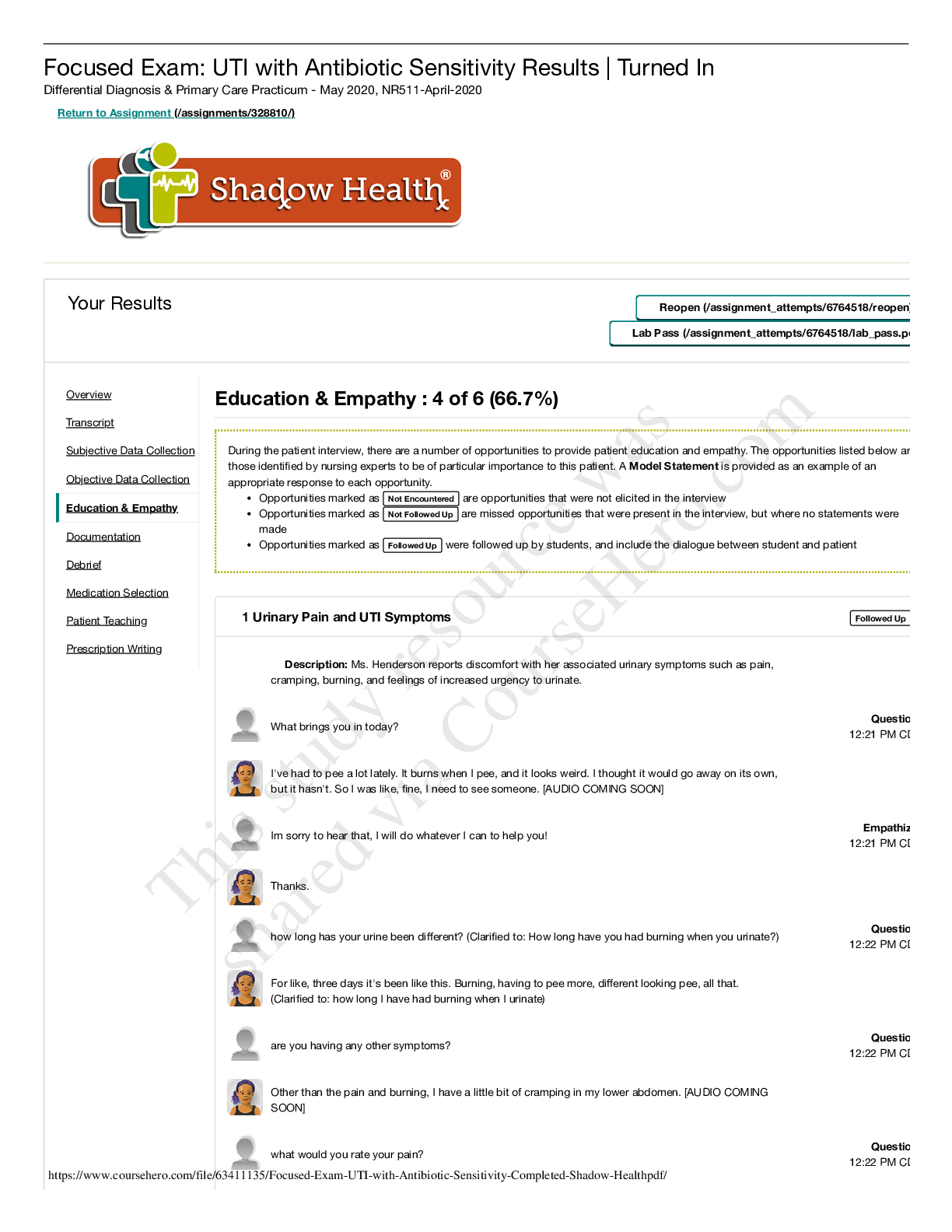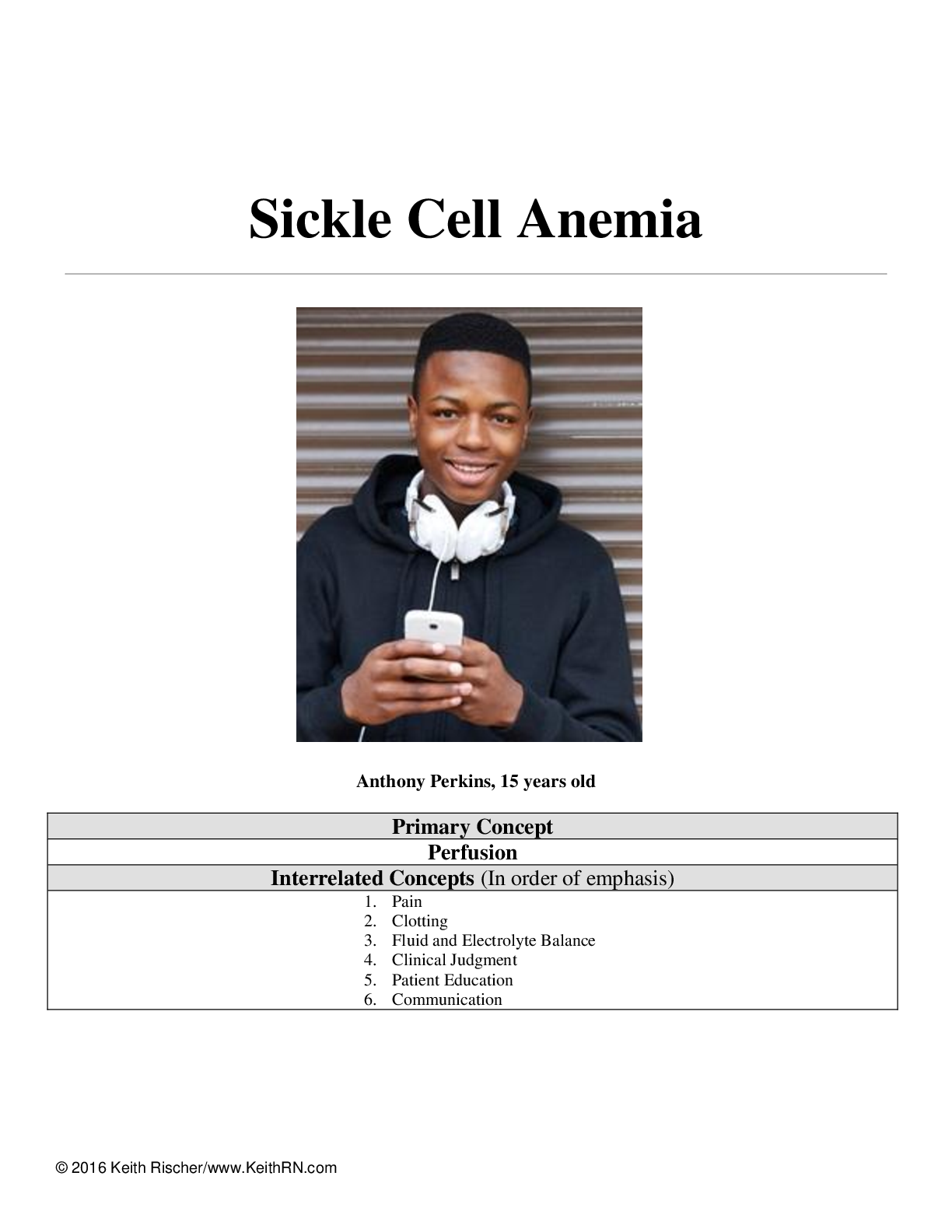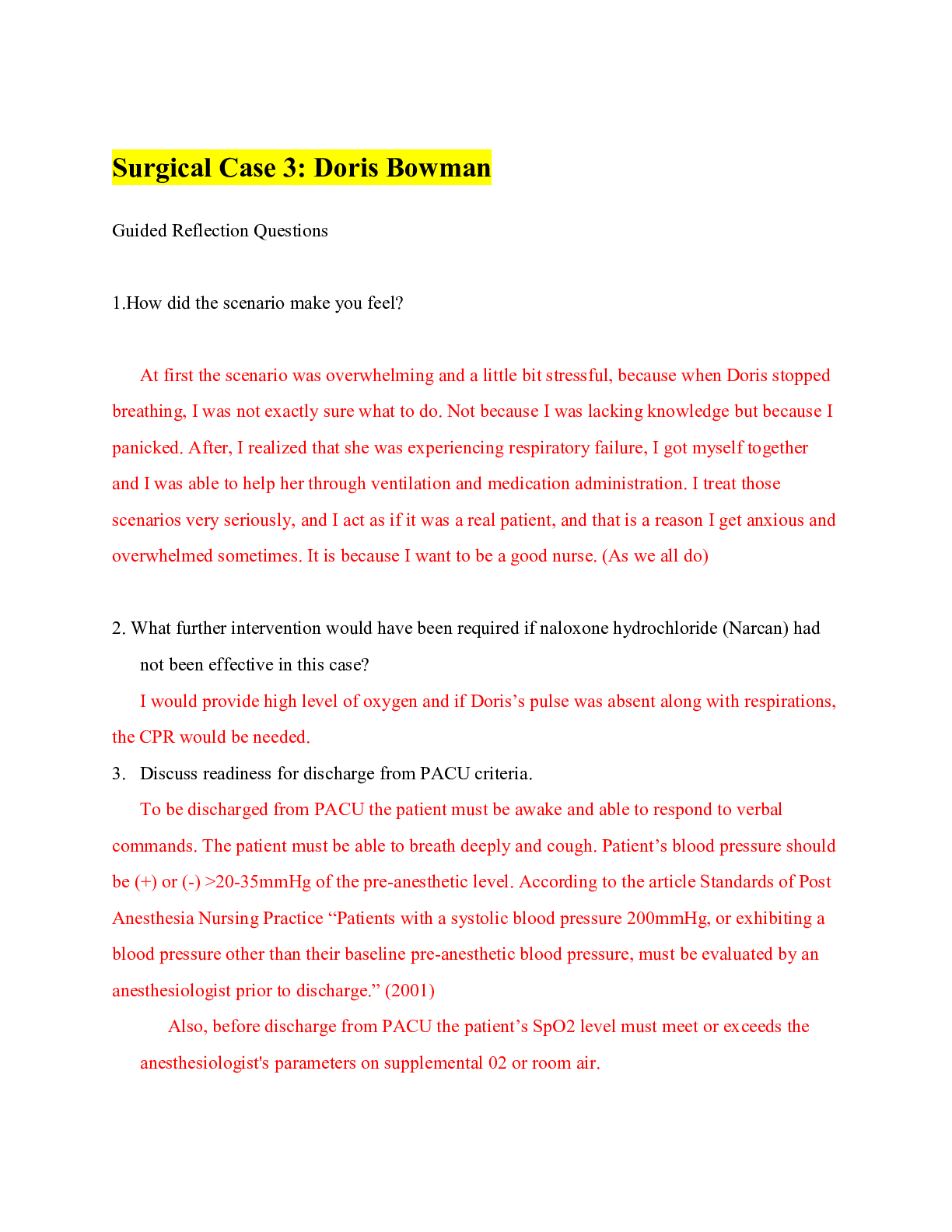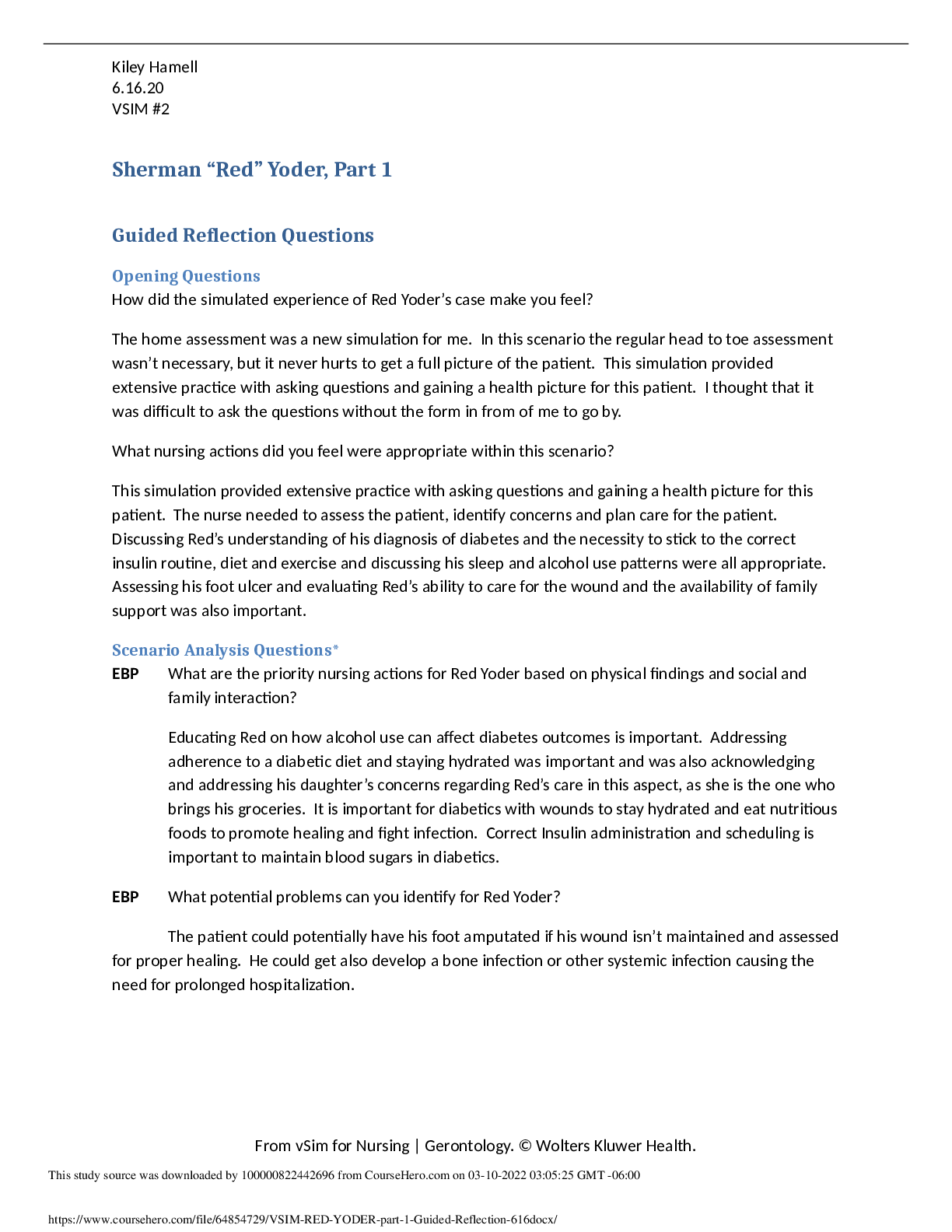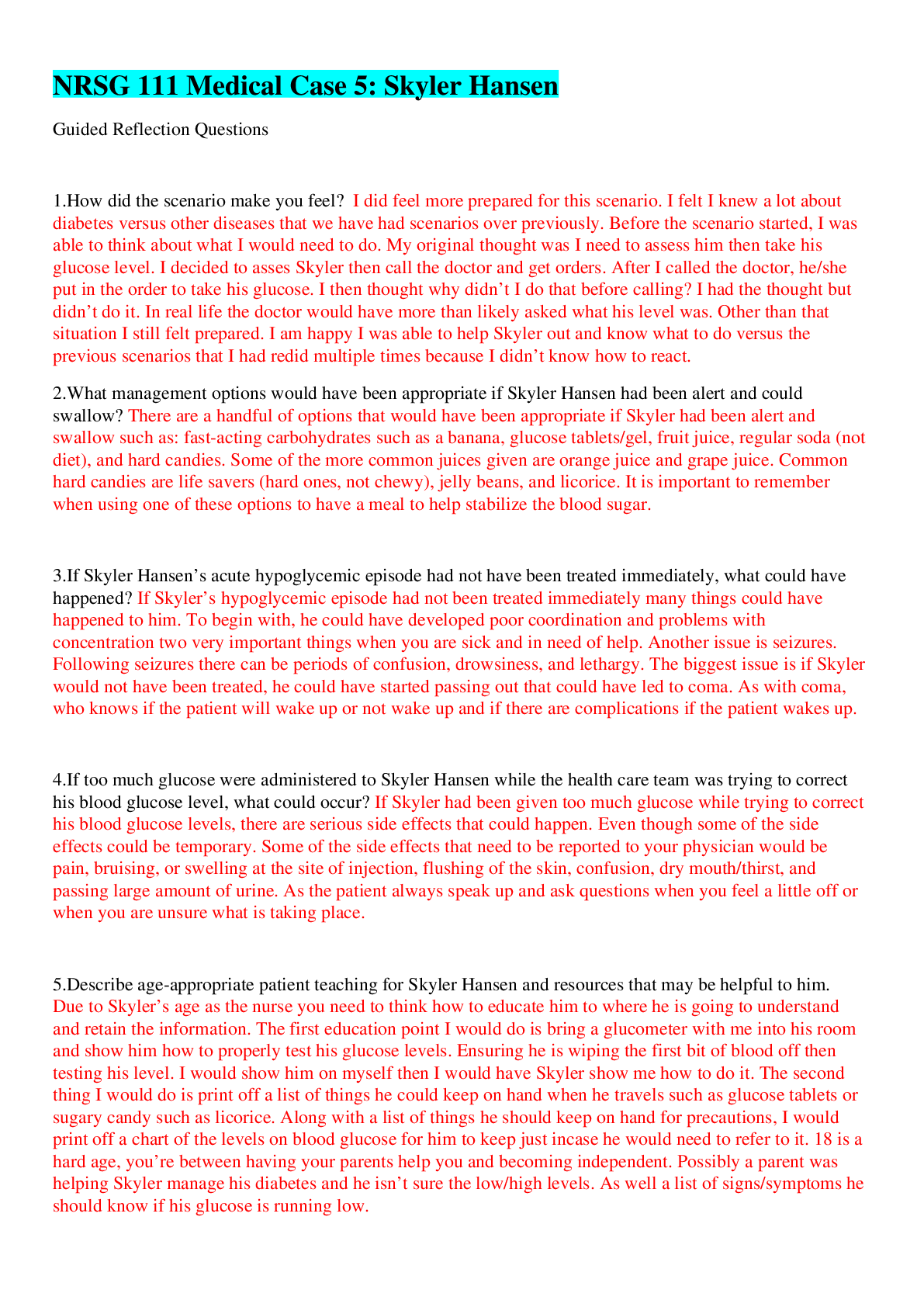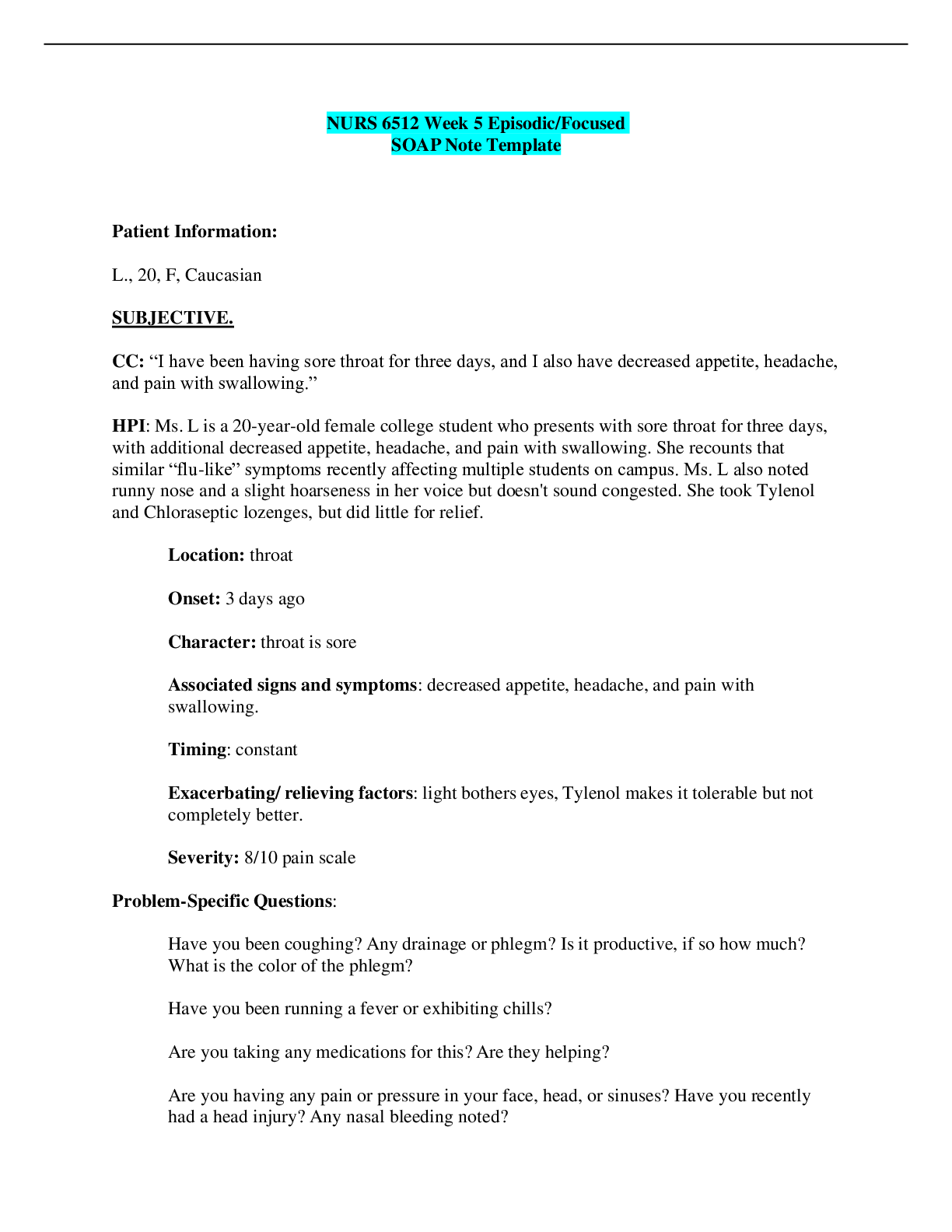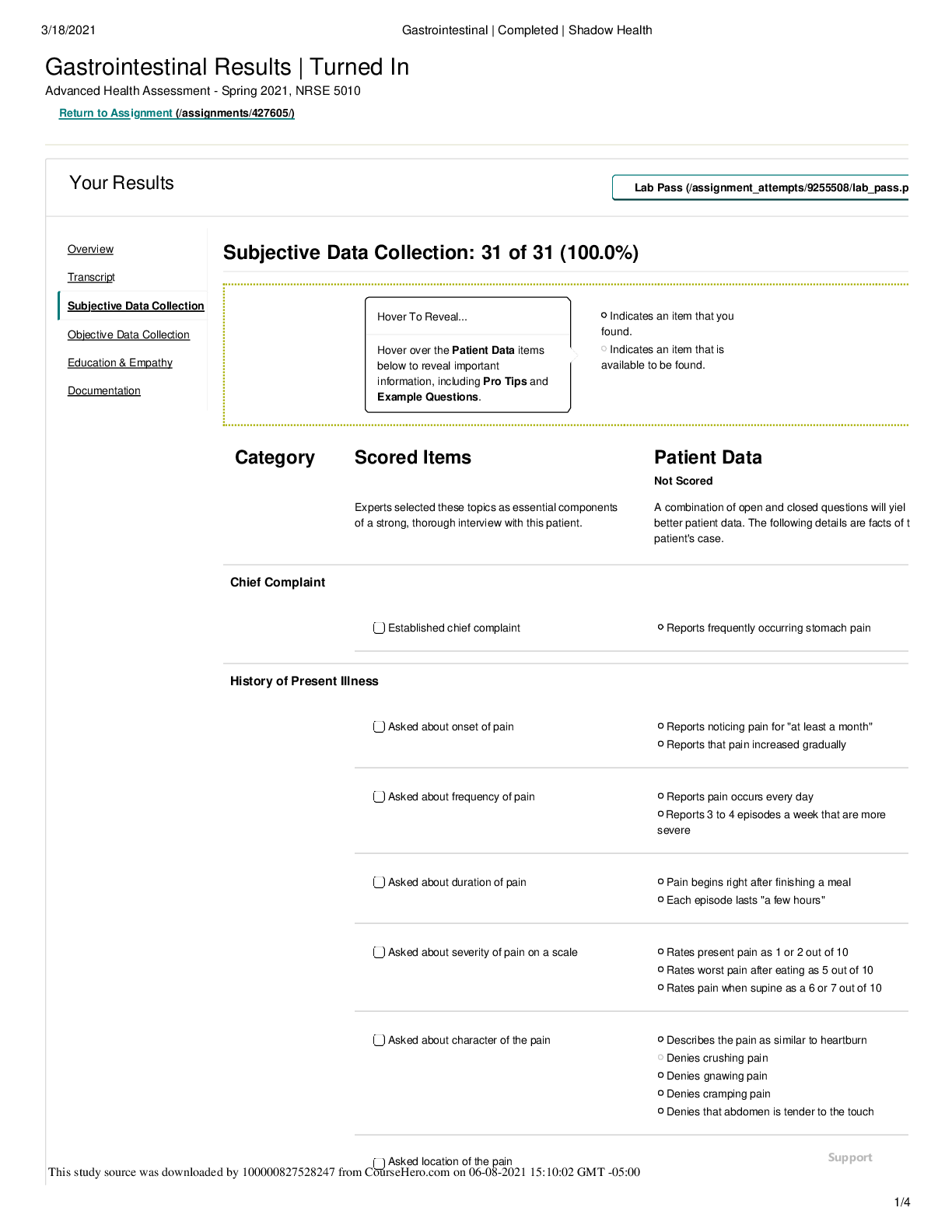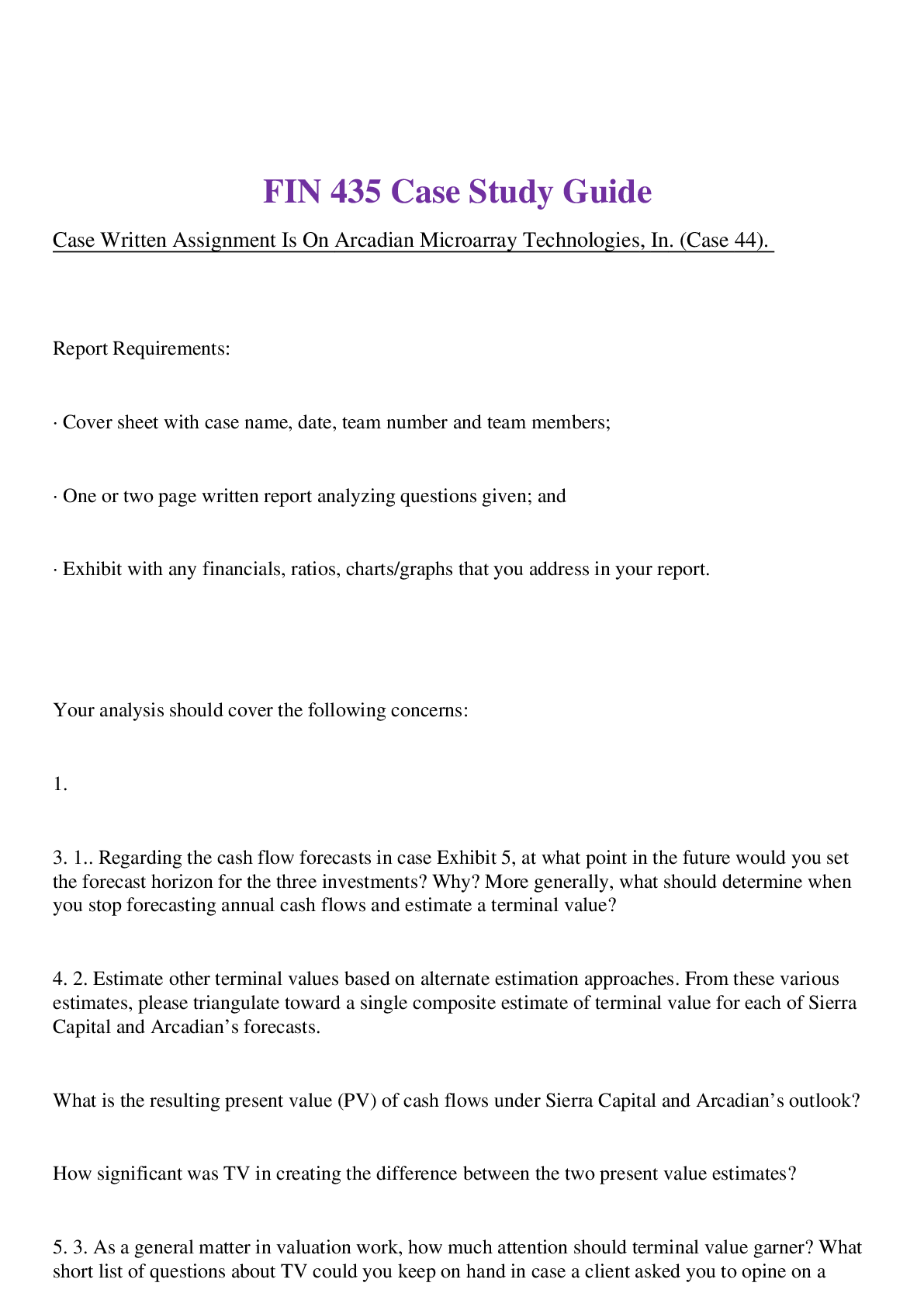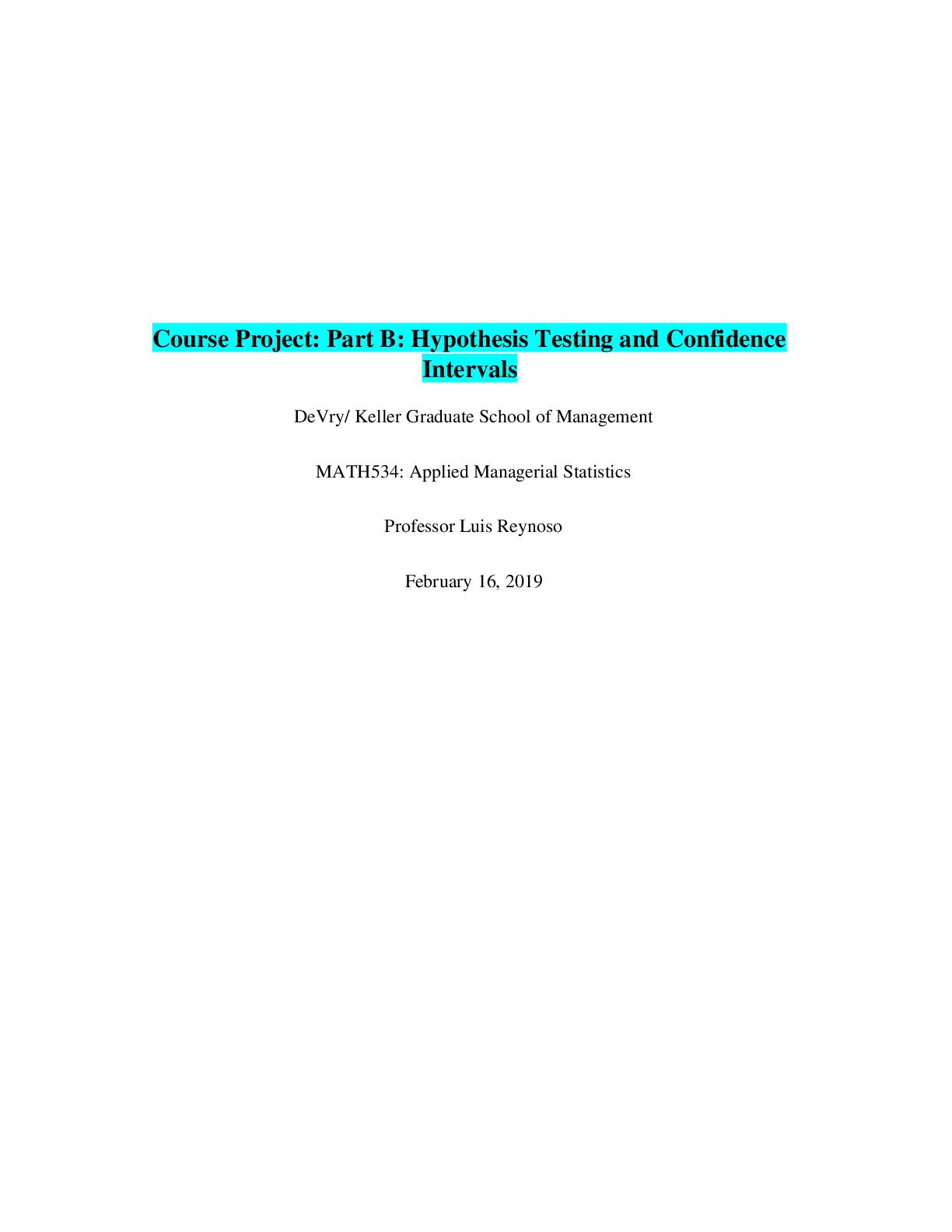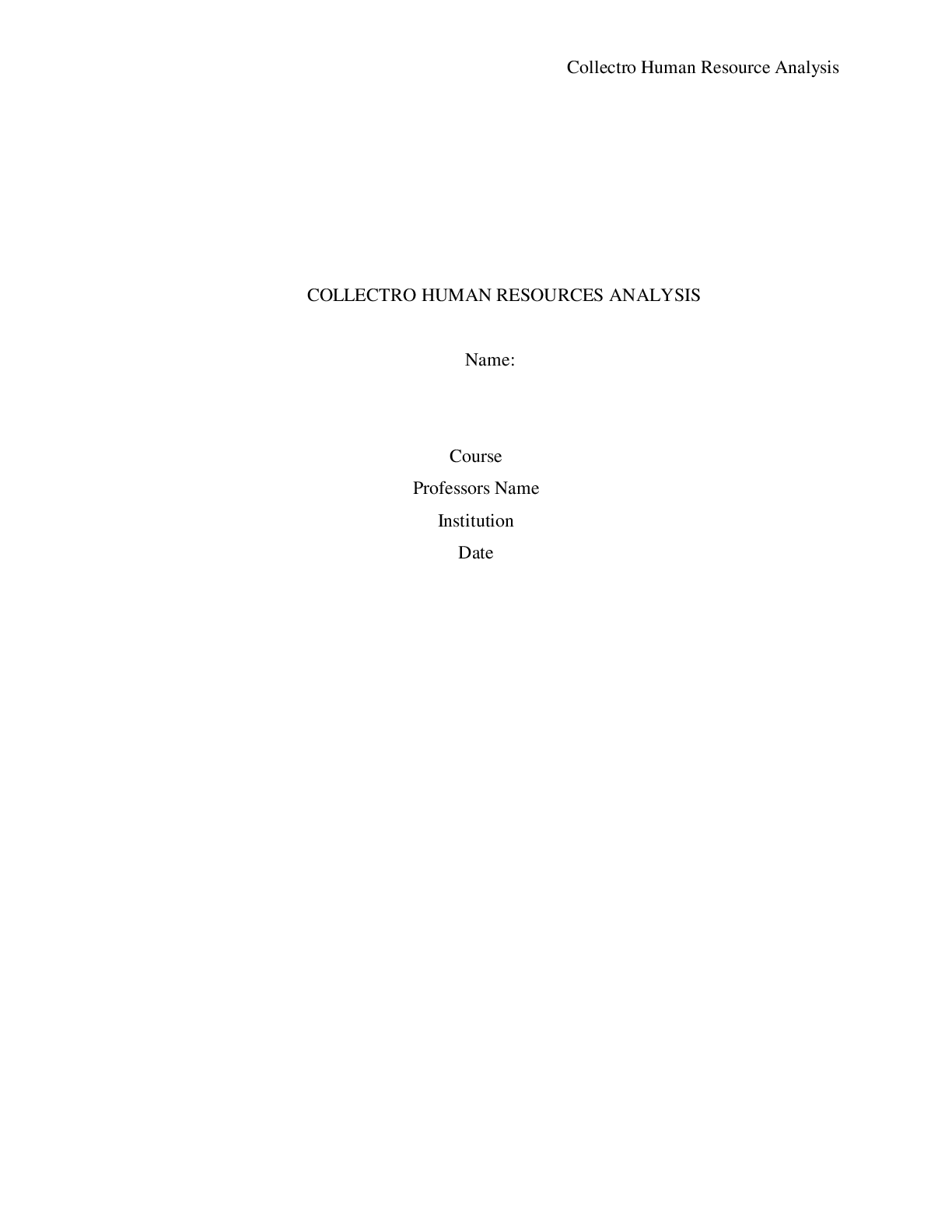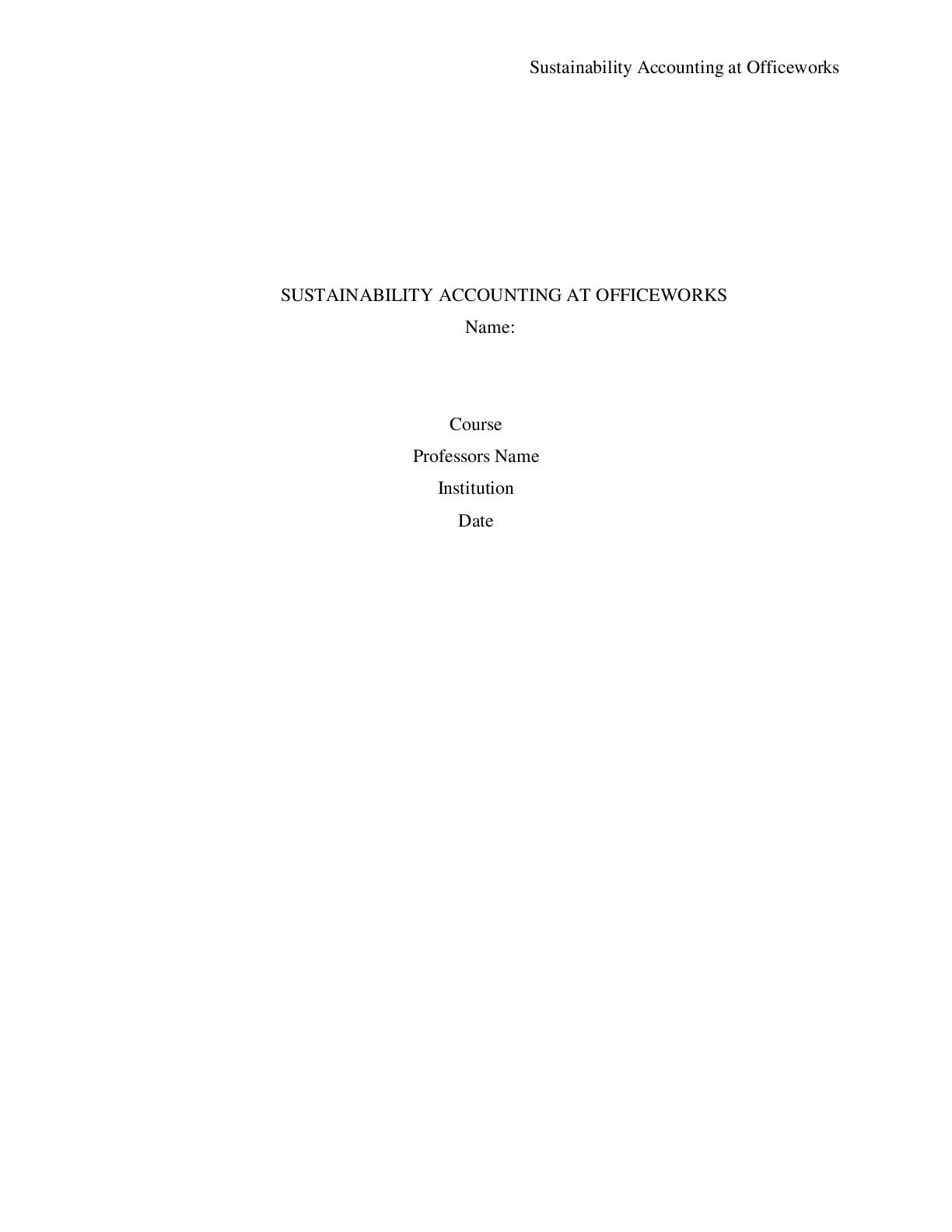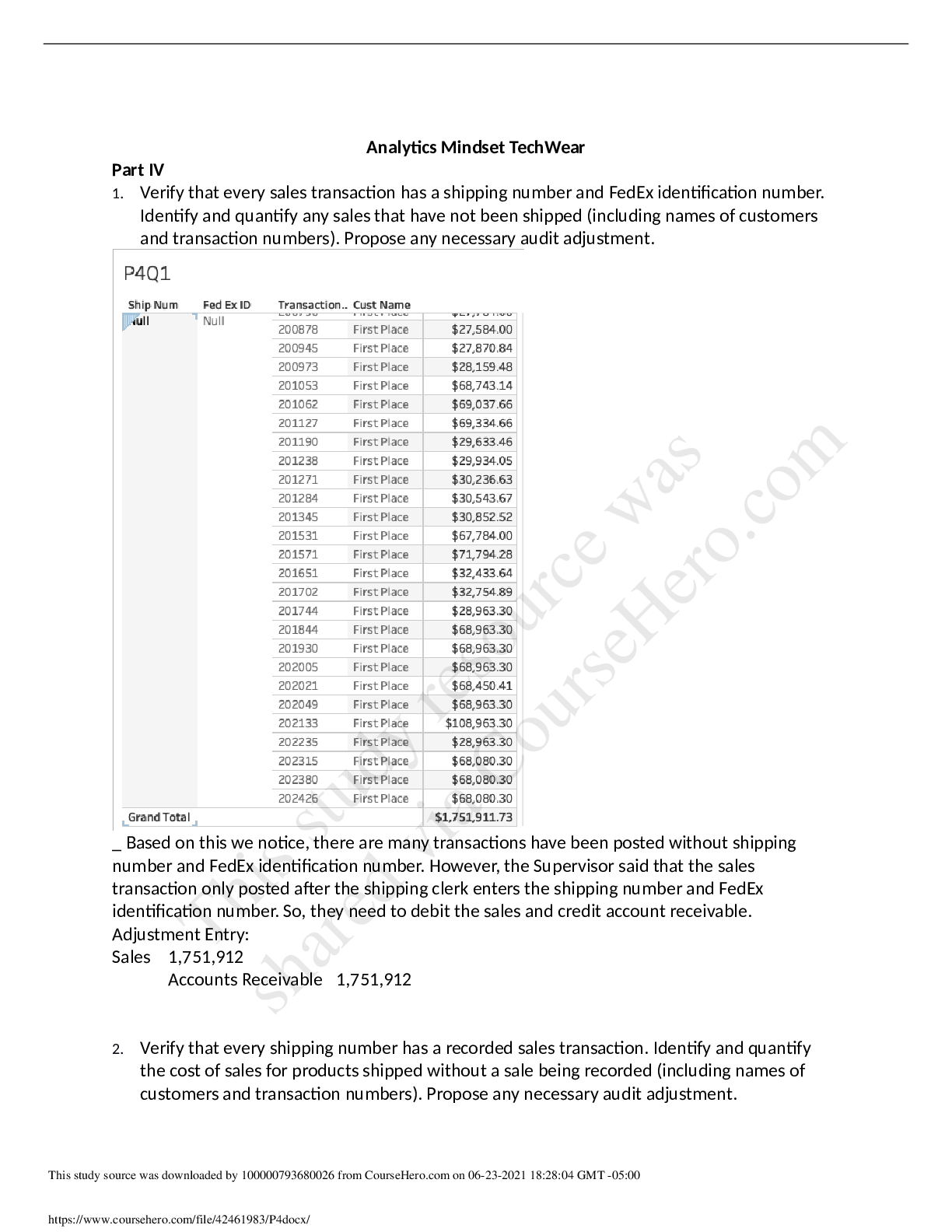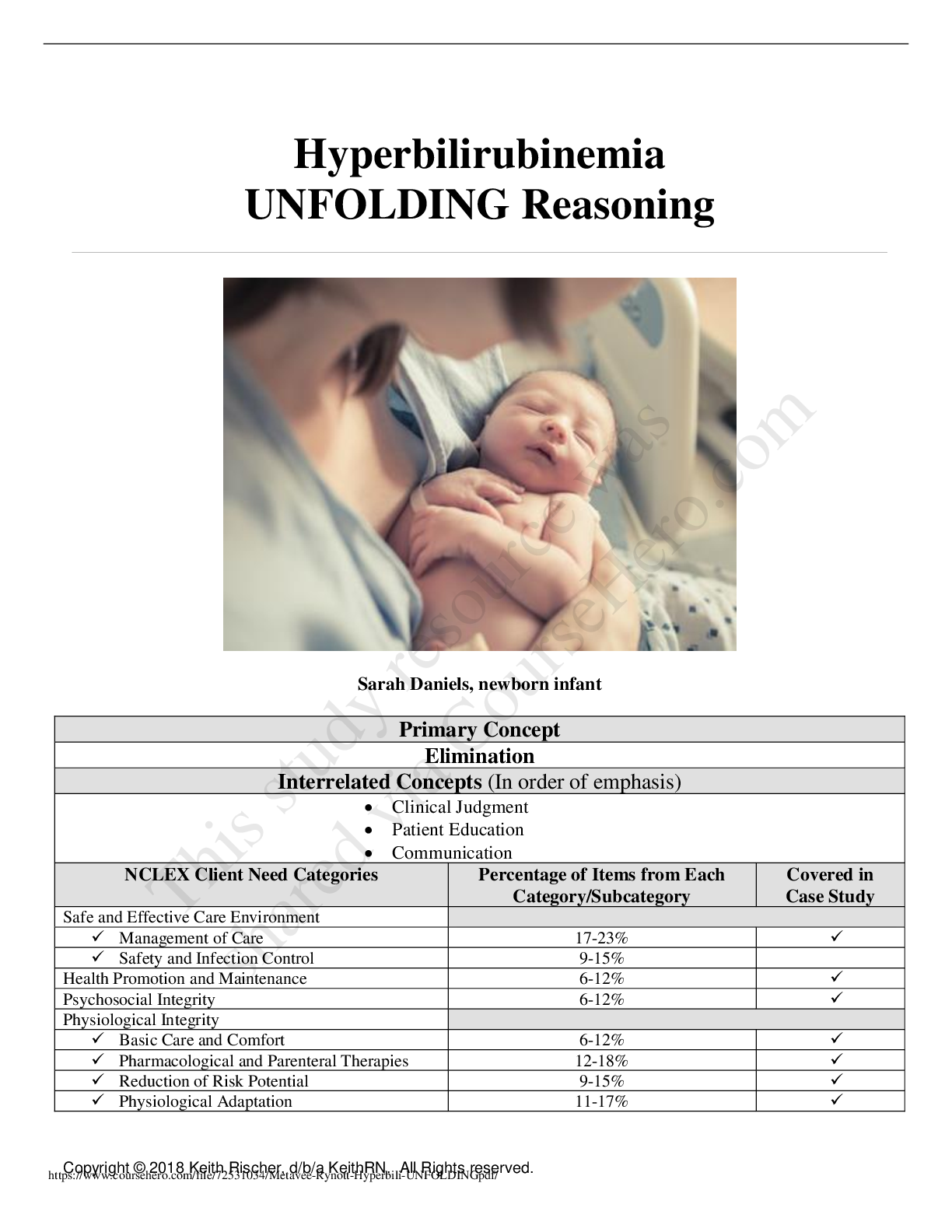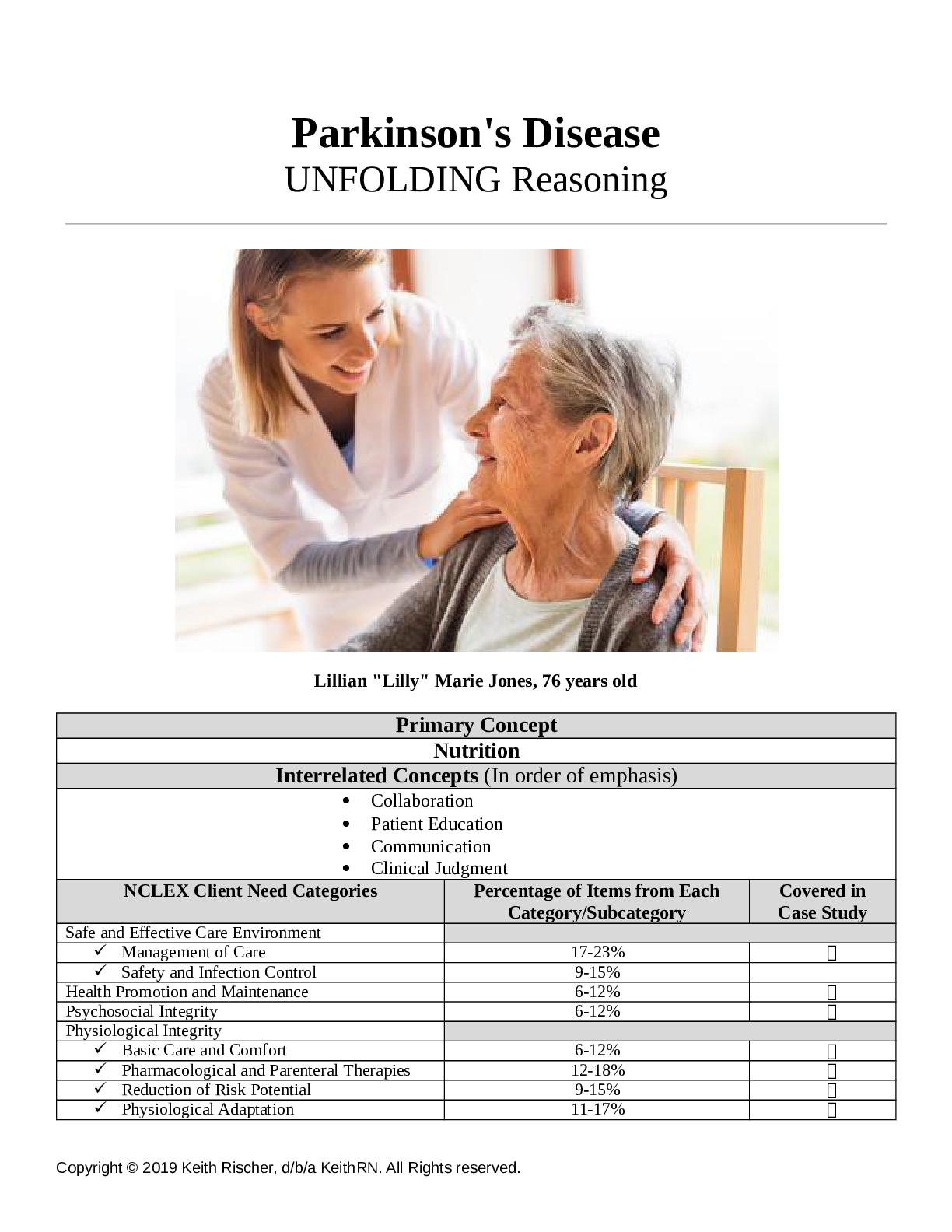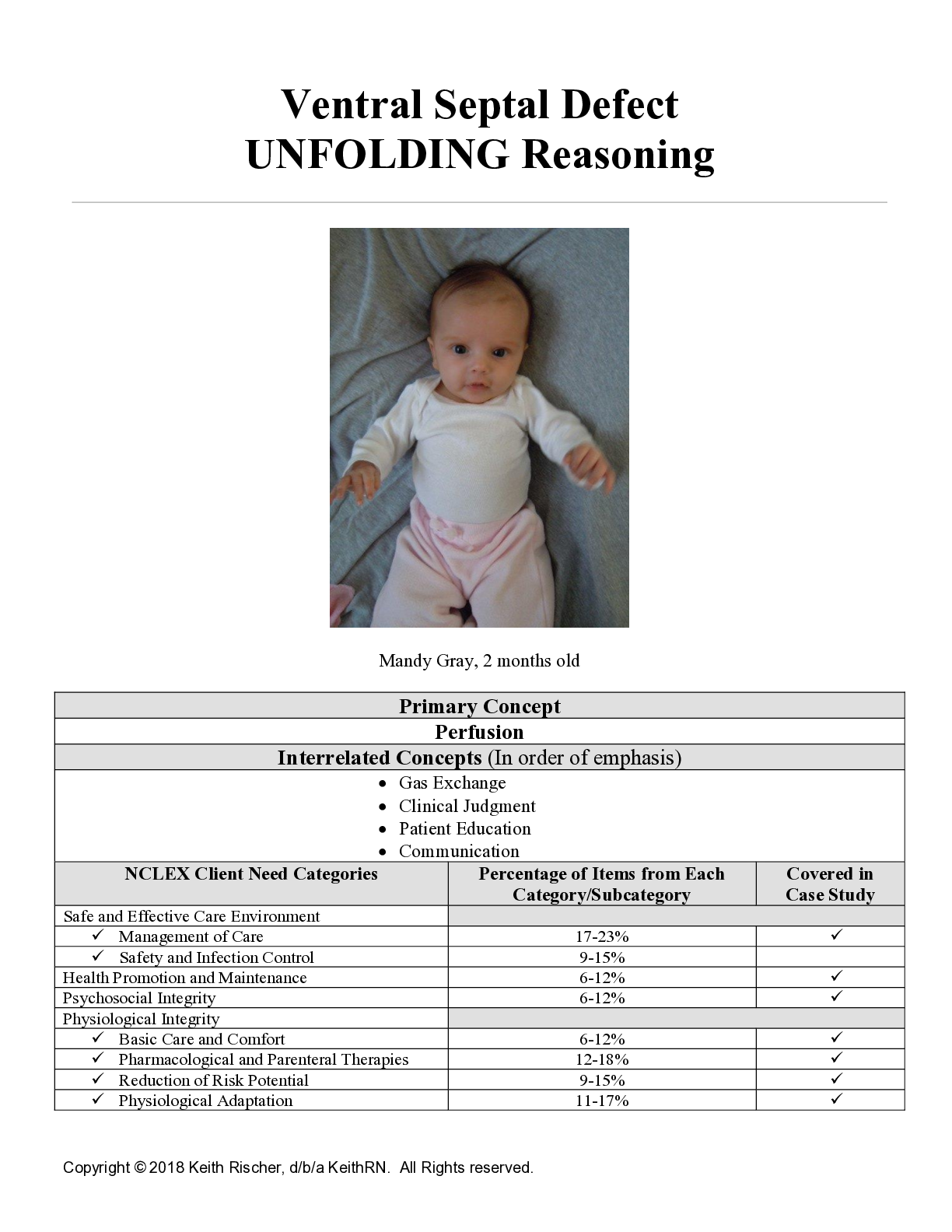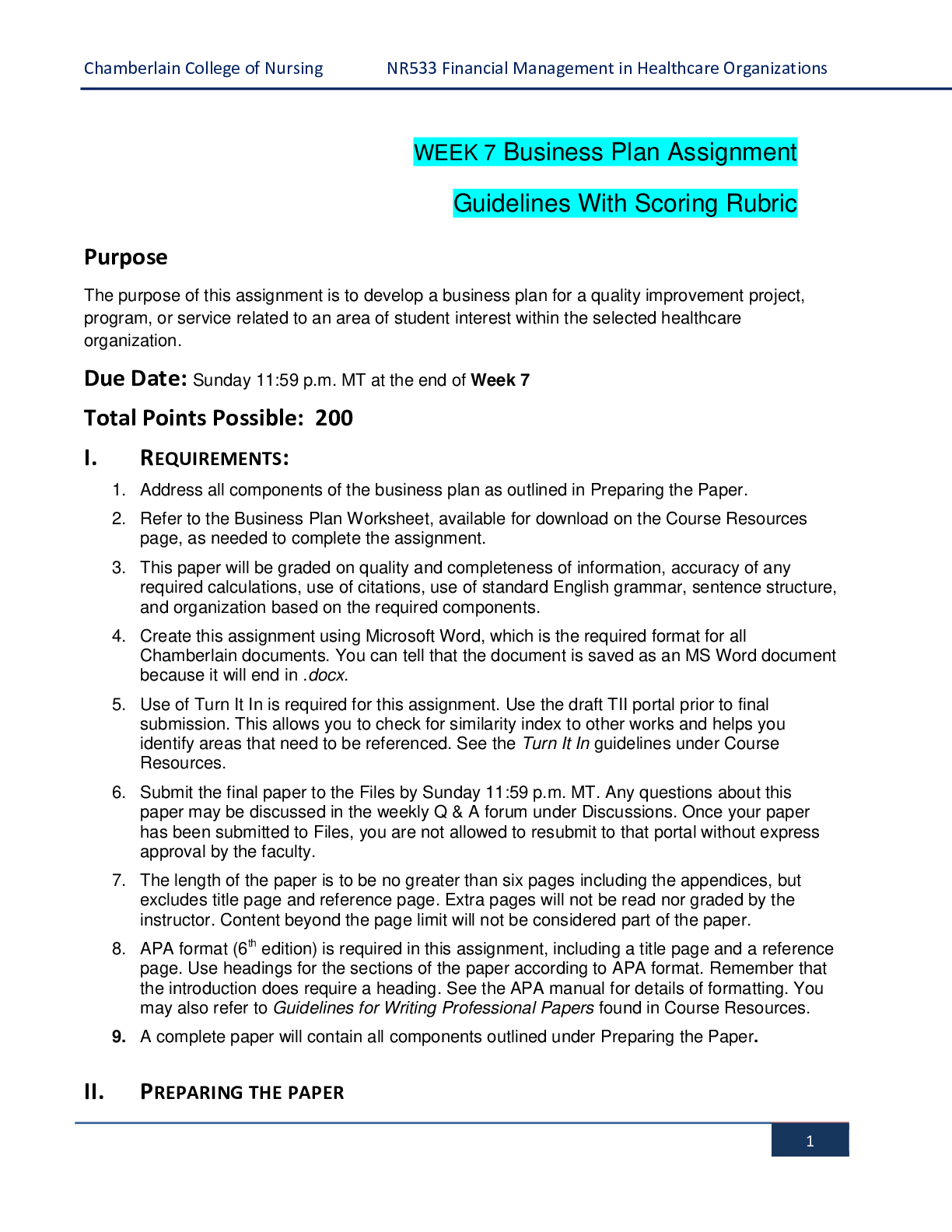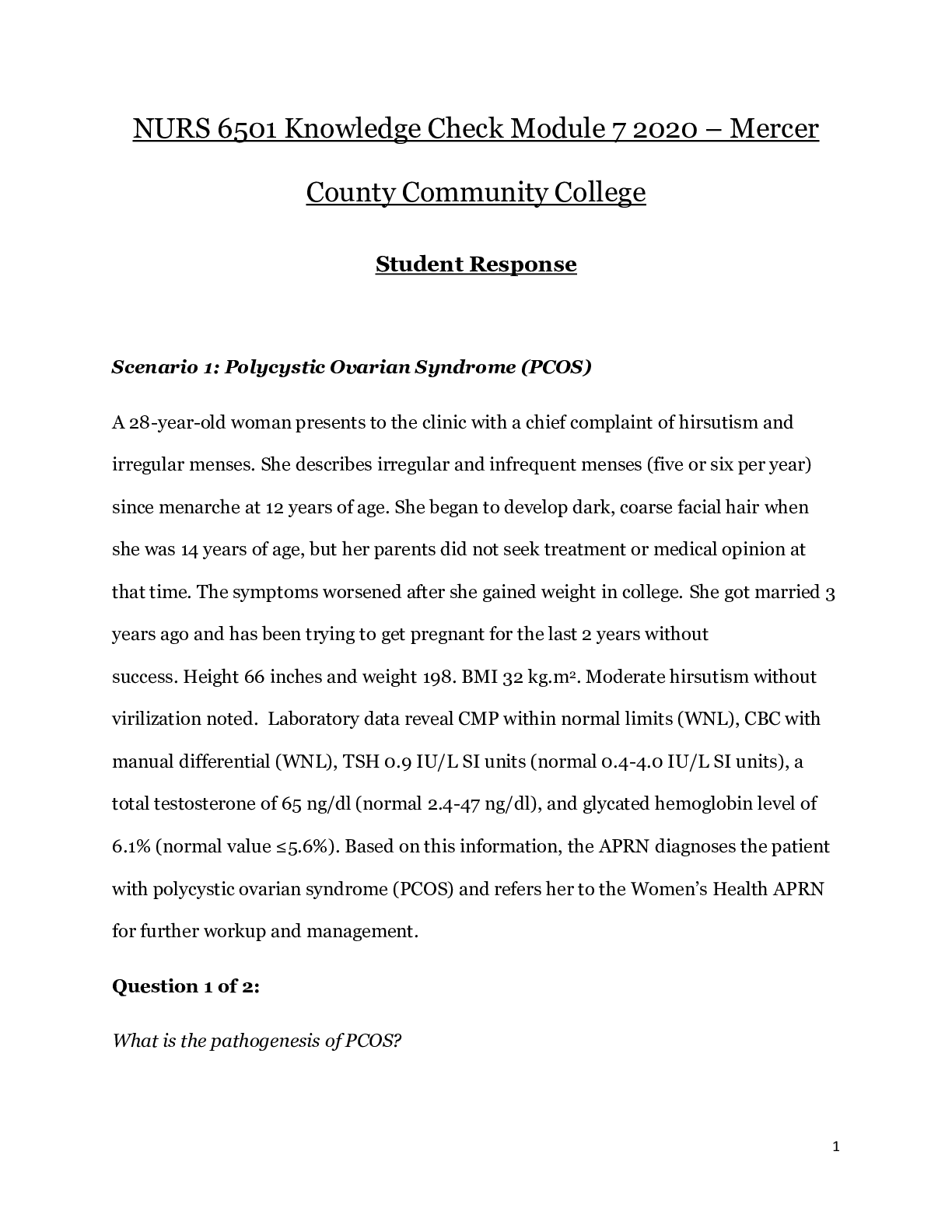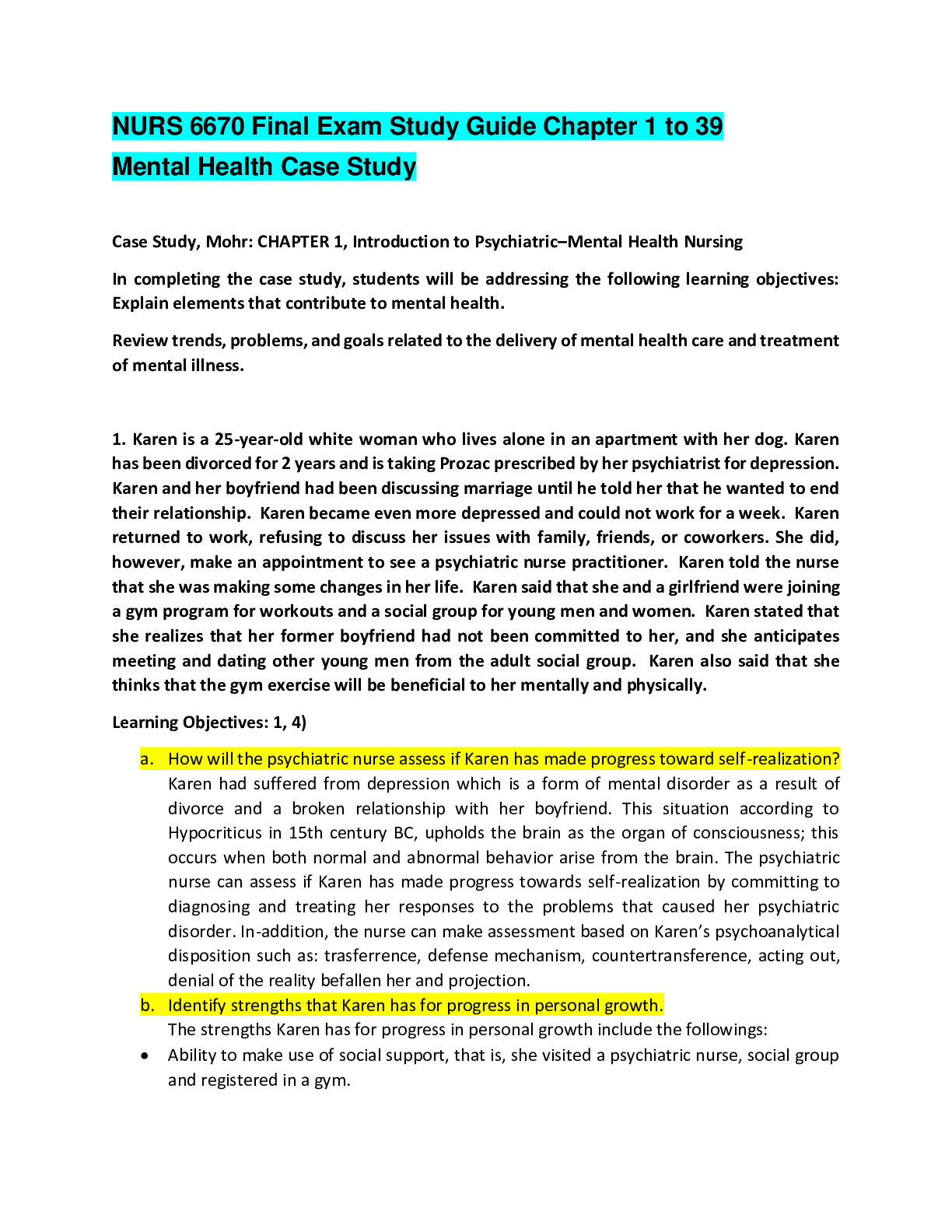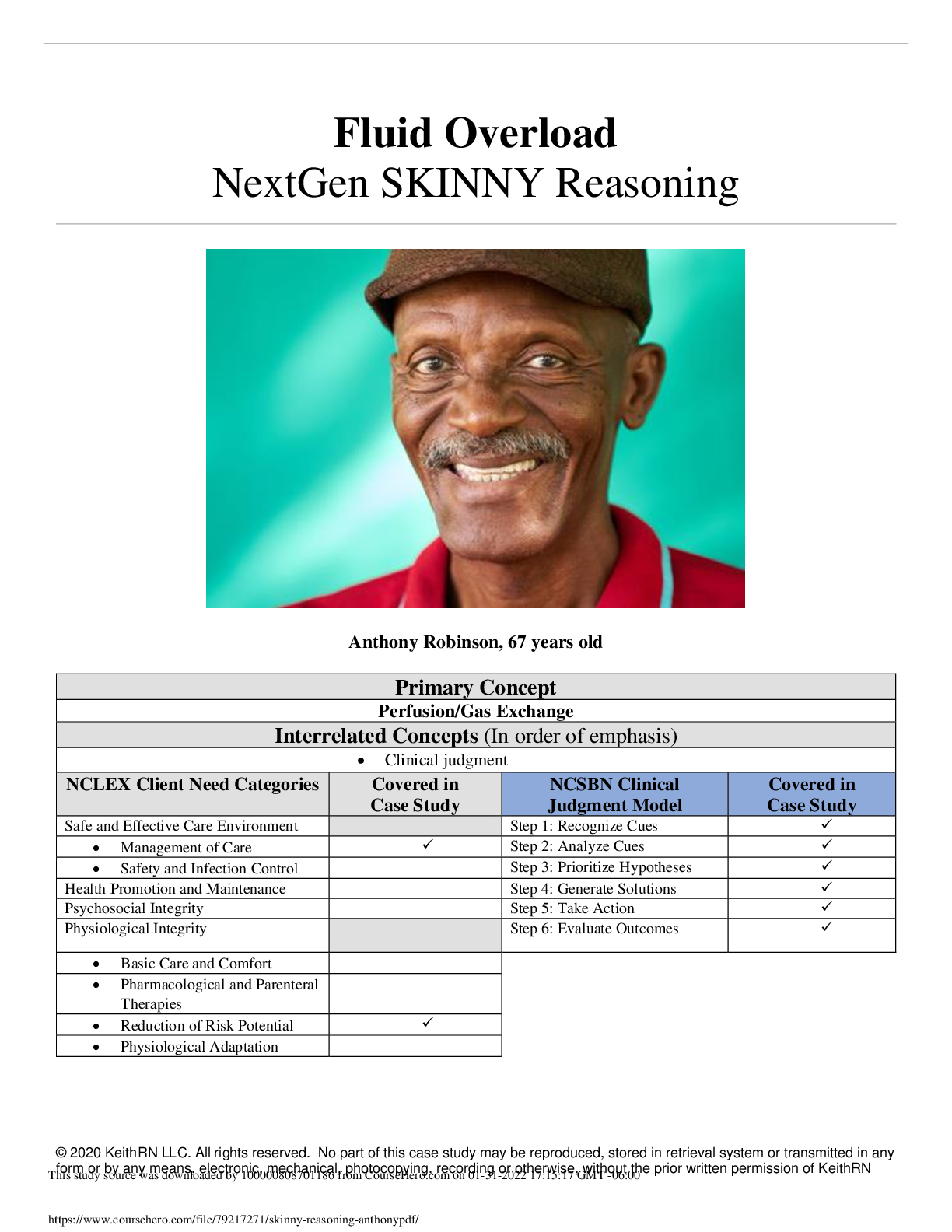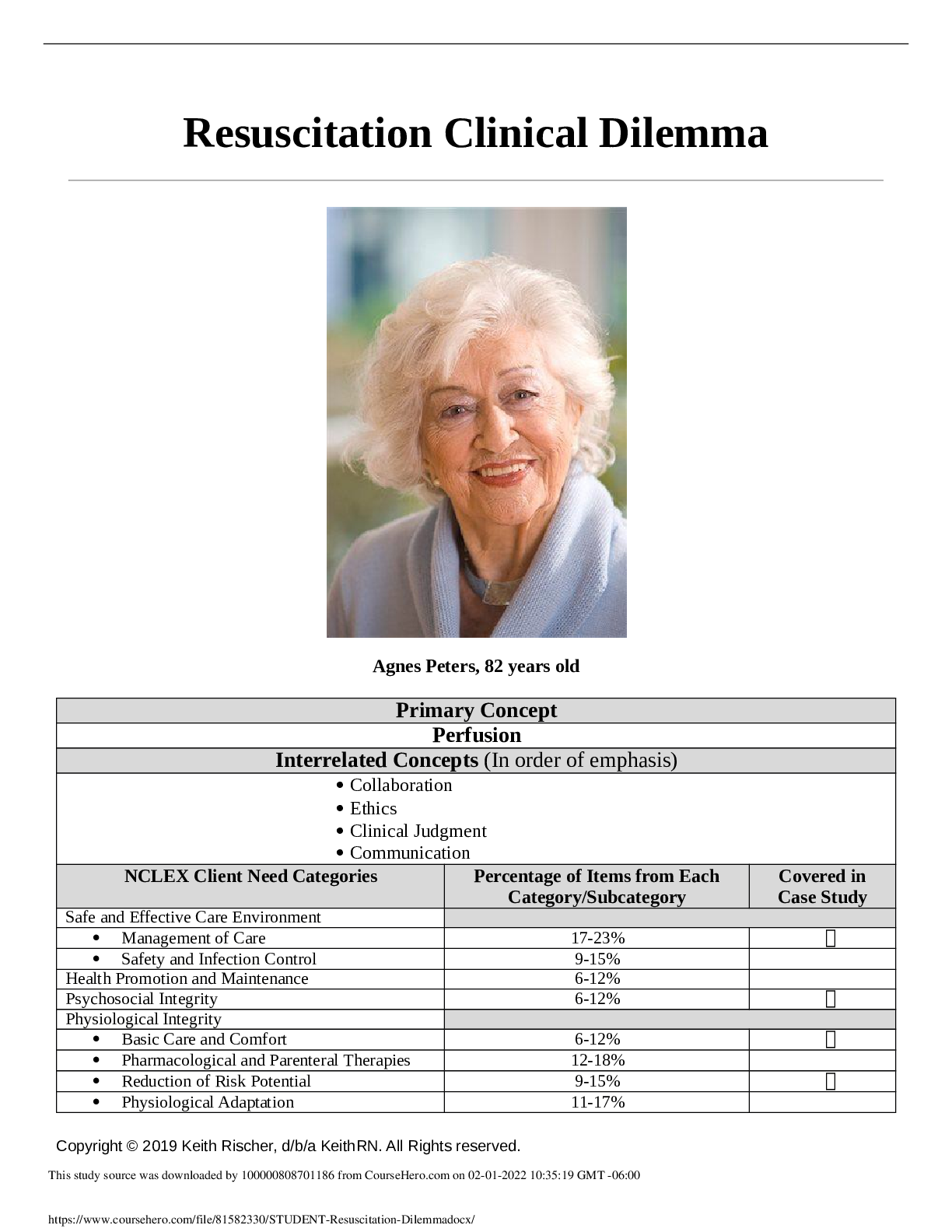*NURSING > CASE STUDY > UNIT IV SCHOLARLY ACTIVITY Latest Graded A (All)
UNIT IV SCHOLARLY ACTIVITY Latest Graded A
Document Content and Description Below
Running head: UNIT IV SCHOLARLY ACTIVITY 1 Unit IV Scholarly Activity Columbia Southern UniversityUNIT IV SCHOLARLY ACTIVITY 2 Data Analysis Describe the Sun Coast Remediation data using the descr... iptive statistics tools discussed in the lecture. Establish whether assumptions are met to use parametric statistical procedures. Repeat this for each tab in the Sun Coast Remediation Research Study data set. Descriptive Data and Assumptions: Correlation Frequency Distribution Table PM size Frequency 0-1 8 2-4 24 5-7 37 8-10 34 Sick Days Frequency 0-2 1 4-7 61 8-9 30 10-12 11 Histogram Descriptive Statistics Table 5 0 10 15 20 25 30 35 40 1 4 7 10 More PM size Histogram for Correlation 0 10 20 30 40 50 60 70 2 7 9 12 More Frequency Sick Days Annual Sick DaysUNIT IV SCHOLARLY ACTIVITY 3 microns sick day Mean 5.65728155 Mean 7.126214 Standard Error 0.25560014 Standard Error 0.186484 Median 6 Median 7 Mode 8 Mode 7 Standard Deviation 2.59405814 Standard Deviation 1.892605 Sample Variance 6.72913764 Sample Variance 3.581953 Kurtosis -0.8521619 Kurtosis 0.124923 Skewness - 0.37325713 Skewness 0.14225 Range 9.8 Range 10 Minimum 0.2 Minimum 2 Maximum 10 Maximum 12 Sum 582.7 Sum 734 Count 103 Count 103 Largest(1) 10 Largest(1) 12 Smallest(1) 0.2 Smallest(1) 2 Confidence Level(95.0%) 0.50698167 Confidence Level(95.0%) 0.36989 Kolmogorov-Smirnov Test The hypotheses used are: Ho: The sample data are not significantly different than a normal population. Ha: The sample data are significantly different than a normal population The Kurtosis -0.852 and the Skewness 0.373 are close to zero and within our range of -2 to 2 and suggest the data is symmetrical. Confirmed by the mean and median being similar. Accept null hypothesis. Measurement Scale Ordinal Measure of Central Tendency MeanUNIT IV SCHOLARLY ACTIVITY 4 Evaluation Normally distributed means that the graph of the data has the shape of a bell curve. Such data is symmetric around its mean and has kurtosis equal to zero. Descriptive Data and Assumptions: Simple Regression Frequency Distribution Table Expenditure Frequency 20-500 108 501-1000 76 1001-1500 27 1501-2000 11 2001-2500 1 Time Frequency 0-50 6 51-100 26 101-200 98 201-300 85 301-400 8 Histogram 0 20 40 60 80 100 120 500 1000 1500 2000 2275 More Frequency Expenditure Training ExpenditureUNIT IV SCHOLARLY ACTIVITY 5 Descriptive Statistics Table safety training expenditure lost time hours Mean 595.9843812 Mean 188.0045 Standard Error 31.4770075 Standard Error 4.803089 Median 507.772 Median 190 Mode 234 Mode 190 Standard Deviation 470.0519613 Standard Deviation 71.72542 Sample Variance 220948.8463 Sample Variance 5144.536 Kurtosis 0.444080195 Kurtosis -0.50122 Skewness 0.951331922 Skewness -0.08198 Range 2251.404 Range 350 Minimum 20.456 Minimum 10 Maximum 2271.86 Maximum 360 Sum 132904.517 Sum 41925 Count 223 Count 223 Largest(1) 2271.86 Largest(1) 360 Smallest(1) 20.456 Smallest(1) 10 Confidence Level(95.0%) 62.03197147 Confidence Level(95.0%) 9.465484 Kolmogorov-Smirnov Test The hypotheses used are: Ho: The sample data are not significantly different than a normal population. Ha: The sample data are significantly different than a normal population 0 20 40 60 80 100 120 50 100 200 300 400 More Frequency Time Lost time hoursUNIT IV SCHOLARLY ACTIVITY 6 The Kurtosis and the Skewness are close to zero and within our range of -2 to 2 and suggest the data is symmetrical. Not confirmed by the mean and median. Reject null hypothesis. Measurement Scale Nominal Measure of Central Tendency Median Evaluation Normally distributed means that the graph of the data has the shape of a bell curve. Such data is symmetric around its mean and has kurtosis equal to zero. Descriptive Data and Assumptions: Multiple Regression Frequency Distribution Table Decibel Frequency 100-106 4 107-111 51 112-116 126 117-121 249 122-131 786 132-141 287 Histogram 0 200 400 600 800 1000 106 111 116 121 131 141 More Frequency Decibles Sound LevelUNIT IV SCHOLARLY ACTIVITY 7 Descriptive Statistics Table Decibel Mean 124.8359 Standard Error 0.177945 Median 125.721 Mode 127.315 Standard Deviation 6.898657 Sample Variance 47.59146 Kurtosis -0.31419 Skewness -0.41895 Range 37.607 Minimum 103.38 Maximum 140.987 Sum 187628.4 Count 1503 Kolmogorov-Smirnov Test The hypotheses used are: Ho: The sample data are not significantly different than a normal population. Ha: The sample data are significantly different than a normal population The Kurtosis and the Skewness are close to zero and within our range of -2 to 2 and suggest the data is symmetrical. Confirmed by the mean and median. Accepted null hypothesis. . Measurement Scale Internal Measure of Central Tendency MeanUNIT IV SCHOLARLY ACTIVITY 8 Evaluation Normally distributed means that the graph of the data has the shape of a bell curve. Such data is symmetric around its mean and has kurtosis equal to zero. Descriptive Data and Assumptions: Independent Samples t Test Frequency Distribution Table Training Frequency 49-60 12 61-70 20 71-80 21 81-90 8 91-100 1 Training Frequency 74-80 14 81-85 21 86-90 19 91-95 6 96-100 2UNIT IV SCHOLARLY ACTIVITY 9 Histogram 5 0 10 15 20 25 60 70 80 90 100 More Frequency Training Histogram Training t Test 5 0 10 15 20 25 80 85 90 95 100 More Frequency Training Histogram trainingUNIT IV SCHOLARLY ACTIVITY 10 Descriptive Statistics Table Prior Training Revised Training Mean 69.79032 Mean 84.77419 Standard Error 1.402788 Standard Error 0.659479 Median 70 Median 85 Mode 80 Mode 85 Standard Deviation 11.04556 Standard Deviation 5.192742 Sample Variance 122.0045 Sample Variance 26.96457 Kurtosis -0.77668 Kurtosis -0.35254 Skewness -0.0868 Skewness 0.144085 Range 41 Range 22 Minimum 50 Minimum 75 Maximum 91 Maximum 97 Sum 4327 Sum 5256 Count 62 Count 62 Largest(1) 91 Largest(1) 97 Smallest(1) 50 Smallest(1) 75 Confidence Level(95.0%) 2.805048 Confidence Level(95.0%) 1.31871 Kolmogorov-Smirnov Test The hypotheses used are: Ho: The sample data are not significantly different than a normal population. Ha: The sample data are significantly different than a normal population The Kurtosis and the Skewness are close to zero and within our range of -2 to 2 and suggest the data is symmetrical. Confirmed by the mean and median. Accepted null hypothesis. Measurement Scale Internal Measure of Central Tendency MeanUNIT IV SCHOLARLY ACTIVITY 11 Evaluation Normally distributed means that the graph of the data has the shape of a bell curve. Such data is symmetric around its mean and has kurtosis equal to zero. Descriptive Data and Assumptions: Dependent Samples t Test Frequency Distribution Table Exposure Frequency 5-15 5 16-25 8 26-35 12 36-45 16 46-56 8 Exposure Frequency 5-15 5 16-25 8 26-35 11 36-45 17 46-56 8 Histogram 5 0 10 15 20 15 25 35 45 56 More Frequency t test Histogram Sample data 2 5 0 10 15 20 15 25 35 45 56 More Frequency t test Histogram Paired Sample DataUNIT IV SCHOLARLY ACTIVITY 12 Descriptive Statistics Table Pre-Exposure μg/dL Post-Exposure μg/dL Mean 32.8571429 Mean 33.28571 Standard Error 1.75230655 Standard Error 1.781423 Median 35 Median 36 Mode 36 Mode 38 Standard Deviation 12.2661458 Standard Deviation 12.46996 Sample Variance 150.458333 Sample Variance 155.5 Kurtosis - 0.57603713 Kurtosis -0.65421 Skewness - 0.42510965 Skewness -0.48363 Range 50 Range 50 Minimum 6 Minimum 6 Maximum 56 Maximum 56 Sum 1610 Sum 1631 Count 49 Count 49 Largest(1) 56 Largest(1) 56 Smallest(1) 6 Smallest(1) 6 Confidence Level(95.0%) 3.52324845 Confidence Level(95.0%) 3.581792 Kolmogorov-Smirnov Test The hypotheses used are: Ho: The sample data are not significantly different than a normal population. Ha: The sample data are significantly different than a normal population The Kurtosis and the Skewness are close to zero and within our range of -2 to 2 and suggest the data is symmetrical. Confirmed by the mean and median. Accepted null hypothesis. Measurement Scale IntervalUNIT IV SCHOLARLY ACTIVITY 13 Measure of Central Tendency Mean Evaluation Normally distributed means that the graph of the data has the shape of a bell curve. Such data is symmetric around its mean and has kurtosis equal to zero. Descriptive Data and Assumptions: ANOVA Frequency Distribution Table Air Frequency 1-3 1 4-6 4 7-9 6 10-12 7 12-15 2 Soil Frequency 5-7 3 8-10 13 10-13 4 Water Frequency 1-3 1 4-6 10 7-9 5 10-12 4 Training Frequency 1-3 1 4-6 16 7-9 3UNIT IV SCHOLARLY ACTIVITY 14 Histogram 8 6 4 2 0 Frequency Air Histogram Air 5 0 10 15 7 10 13 More Frequency Soil Histogram Soil 5 0 10 15 3 6 9 12 More Frequency Water Histogram Water 5 0 10 15 20 3 6 9 More Frequency Training Histogram TrainingUNIT IV SCHOLARLY ACTIVITY 15 Descriptive Statistics Table A = Air B = Soil Mean 8.9 Mean 9.1 Standard Error 0.684028 Standard Error 0.390007 Median 9 Median 9 Mode 11 Mode 8 Standard Deviation 3.059068 Standard Deviation 1.744163 Sample Variance 9.357895 Sample Variance 3.042105 Kurtosis -0.6283 Kurtosis 0.11923 Skewness -0.36085 Skewness 0.492002 Range 11 Range 7 Minimum 3 Minimum 6 Maximum 14 Maximum 13 Sum 178 Sum 182 Count 20 Count 20 Largest(1) 14 Largest(1) 13 Smallest(1) 3 Smallest(1) 6 Confidence Level(95.0%) 1.431688 Confidence Level(95.0%) 0.816294 C = Water D = Training Mean 7 Mean 5.4 Standard Error 0.575829 Standard Error 0.265568 Median 6 Median 5 Mode 6 Mode 5 Standard Deviation 2.575185 Standard Deviation 1.187656 Sample Variance 6.631579 Sample Variance 1.410526 Kurtosis -0.23752 Kurtosis 0.253747 Skewness 0.760206 Skewness 0.159183 Range 9 Range 5 Minimum 3 Minimum 3 Maximum 12 Maximum 8 Sum 140 Sum 108 Count 20 Count 20 Largest(1) 12 Largest(1) 8 Smallest(1) 3 Smallest(1) 3 Confidence Level(95.0%) 1.205224 Confidence Level(95.0%) 0.55584UNIT IV SCHOLARLY ACTIVITY 16 Kolmogorov-Smirnov Test The hypotheses used are: Ho: The sample data are not significantly different than a normal population. Ha: The sample data are significantly different than a normal population The Kurtosis and the Skewness are close to zero and within our range of -2 to 2 and suggest the data is symmetrical. Confirmed by the mean and median. Accepted null hypothesis. Measurement Scale Ratio Measure of Central Tendency Mean Evaluation Normally distributed means that the graph of the data has the shape of a bell curve. Such data is symmetric around its mean and has kurtosis equal to zero.UNIT IV SCHOLARLY ACTIVITY 17 References Creswell, J. W., & Creswell, J. D. (2018). Research design: Qualitative, quantitative, and mixed methods approaches (5th ed.). Thousand Oaks, CA: Sage.UNIT IV SCHOLARLY ACTIVITY 18 Appendix Copy and paste your Kolmogorov-Smirnov Test table and results from Excel into this appendix. [Show More]
Last updated: 1 year ago
Preview 1 out of 18 pages
Instant download
.png)
Instant download
Reviews( 0 )
Document information
Connected school, study & course
About the document
Uploaded On
May 16, 2021
Number of pages
18
Written in
Additional information
This document has been written for:
Uploaded
May 16, 2021
Downloads
0
Views
64

